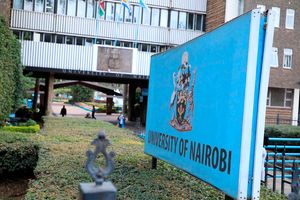
The cash crunch in public universities has deepened after unpaid salaries, wages, retirement benefits and medical cover jumped by a fifth to Sh45.33 billion last financial year.
The Sh8.01 billion or 21.46 percent increase in pay arrears for current and former employees as well as entitled social benefits in 12 months through June 2023 signals a growing cash flow crisis at Kenya’s institutions of higher learning.
This will likely present a major financial headache to university administrators at a time the number of candidates attaining minimum entry grade crossed the 200,000 mark for the first time.
The data from Higher Education and Research department shows unpaid wages to the university employees stood at Sh33.50 billion in the review year, accounting for slightly more than half of the total pending bills.
The employees’ pay arrears grew 16.10 percent over Sh28.85 billion the year before, the data indicate.
The total pending bills at about 42 public universities and university colleges rose 16.66 percent year-on-year to Sh61.25 billion, the data contained in the budget review report states.
The rising compensation to employees has over the years put the university administrators on a collision course with the staff unions.
Unions such as the Universities Academic Staff Union (UASU) and Kenya Universities Staff Union for non-teaching workers have downed tools, paralysing learning in institutions such as Egerton and Moi over unpaid wages.
The biting cash crunch has in the past been linked to lower per capita budgetary allocation despite the growing enrolment of government-sponsored students.
The rising enrolment is a policy shift by the previous regime of President Uhuru Kenyatta to partly sponsor all students who meet the minimum entry grade C+ (plus) in Kenya Certificate of Secondary Education (KCSE) examinations.
Higher Education Principal Secretary Beatrice Inyangala has said the previous administration had failed to release up to 32 percent capitation to the institution’s estimates for the financial year ending June 2023.
Inadequate funding, Dr Inyangala told lawmakers in May 2023 while presenting views on budget for the year ending June 2024, had resulted in universities defaulting on remitting statutory deductions such as payroll taxes to the Kenya Revenue Authority.
The data shows accrued social benefits not remitted to statutory bodies such as National Social Security Fund and National Health Insurance Fund increased to Sh11.83 billion last fiscal year ended June 2023 from Sh8.47 billion (June 2022) and Sh7.55 billion (June 2021).
The Higher Education and Research unit will be presenting the arrears accrued between June 2005 and June 2022 to the Pending Bills Verification Committee chaired by former Auditor-General, Edward Ouko, on January 31.
The committee will be receiving submissions from accounting officers for State ministries, departments and agencies between January 29 and February 2 for verification and recommend to the Treasury ways of settlement.
Universities Fund – the State agency managing the financing of universities— had said it planned to hold talks with other State agencies to find modalities of separating the actual pending bills, the penalties and the interests thereof.
“Once we get those figures, then we shall be able to negotiate with these agencies including [the] Kenya Revenue Authority (KRA), the National Health Insurance Fund (NHIF) and the National Social Securities Fund (NSSF),” Universities Fund chief executive Geoffrey Monari said in May 2023 before the committee was formed.
The State funding to universities was previously based on the differentiated unit cost model with allocations based on the number of undergraduate students on the regular programme and their courses. Under the model, the government was expected to cater for 80 percent of the unit cost while the remainder was borne by students and institutions.
“Funding TVET and universities in Kenya over the years has continued to experience challenges,” the Treasury wrote in the draft 2024 Budget Policy Statement. “The new model for financial support is student-centred and deploys a rigorous, impartial means testing instrument to establish their level of need, which then becomes the primary consideration in allocating scholarships and loans.”
The funding pressure is set to mount from September on expected increased enrolment after candidates who met minimum university entry in last year’s KCSE grew 16 percent to 201,133 from 173,345 students the year before.







